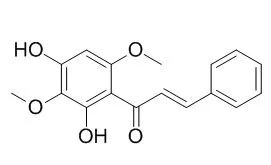| In vitro: |
| Phytomedicine. 2014 Oct 15;21(12):1651-7. | | Cytotoxicity and modes of action of 4'-hydroxy-2',6'-dimethoxychalcone and other flavonoids toward drug-sensitive and multidrug-resistant cancer cell lines.[Pubmed: 25442273] | Resistance of cancer to chemotherapy is a main cause in treatment failure. Naturally occurring chalcones possess a wide range of biological activities including anti-cancer effects.
METHODS AND RESULTS:
In this work, we evaluated the antiproliferative activity of three chalcones [4'-hydroxy-2',6'-dimethoxychalcone (1), cardamomin (2), 2',4'-Dihydroxy-3',6'-dimethoxychalcone (3)], and four flavanones [(S)-(-)-pinostrobin (4), (S)-(-)-onysilin (5) and alpinetin (6)] toward nine cancer cell lines amongst which were multidrug resistant (MDR) types. | | Planta Med. 2012 May;78(8):787-92. | | Cytotoxicity and antimicrobial activity of the methanol extract and compounds from Polygonum limbatum.[Pubmed: 22495442 ] | The present study was designed to investigate the antimicrobial activity and the cytotoxicity of the methanol extract (PLA) as well as fractions (PLA1-4) and compounds [cardamomin (1), (±)-polygohomoisoflavanone (2), (S)-(-)-pinostrobin (3), 2',4'-Dihydroxy-3',6'-dimethoxychalcone (4), (2S)-(-)-5-hydroxy-6,7-dimethoxyflavanone (5), and (2S)-(-)-5,7-dimethoxyflavanone (6)] obtained from leaves of Polygonum limbatum.
METHODS AND RESULTS:
The microbroth dilution was used to determine the minimal inhibitory concentration (MIC) of the samples against 11 microbial strains including Candida albicans, C. krusei, C. tropicalis, Aspergillus fumigatus, Pseudomonas aeruginosa, Escherichia coli, vancomycin-resistant Enterococcus faecalis (VRE), Staphylococcus aureus, methicillin-resistant S. aureus (MRSA), S.epidermidis, and Mycobacterium tuberculosis H37Rv. The sulphorhodamine B cell growth inhibition assay was used to assess the cytotoxicity of the above samples on lung A549 adenocarcinoma, breast carcinoma MCF-7, prostate carcinoma PC-3, cervical carcinoma HeLa, and the acute monocytic leukemia cell line THP-1. The results of the MIC determination indicated that, apart from fraction PLA3, all other fractions as well as PLA and compound 3 were selectively active. MIC values were noted on 100 % of the 11 tested microorganisms for fraction PLA3, 72.7 % for PLA, fraction PLA2, and compound 4, 63.6 % for PLA1, and 54.5 % for fraction PLA4. The results of the cytotoxicity assay revealed that, except for A459 cells, more than 50 % inhibition of the proliferation was obtained with each of the tested samples on at least one of the four other cell lines. IC₅₀ values below 4 µg/mL were obtained with 1 and 4 on THP-1 cells.
CONCLUSIONS:
The overall results of the present study provided baseline information for the possible use of Polygonum limbatum as well as some of the isolated compounds for the control of cancer diseases and mostly leukemia. |
|






 Cell. 2018 Jan 11;172(1-2):249-261.e12. doi: 10.1016/j.cell.2017.12.019.IF=36.216(2019)
Cell. 2018 Jan 11;172(1-2):249-261.e12. doi: 10.1016/j.cell.2017.12.019.IF=36.216(2019) Cell Metab. 2020 Mar 3;31(3):534-548.e5. doi: 10.1016/j.cmet.2020.01.002.IF=22.415(2019)
Cell Metab. 2020 Mar 3;31(3):534-548.e5. doi: 10.1016/j.cmet.2020.01.002.IF=22.415(2019) Mol Cell. 2017 Nov 16;68(4):673-685.e6. doi: 10.1016/j.molcel.2017.10.022.IF=14.548(2019)
Mol Cell. 2017 Nov 16;68(4):673-685.e6. doi: 10.1016/j.molcel.2017.10.022.IF=14.548(2019)